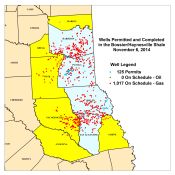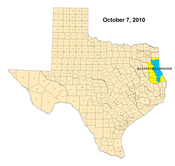Haynesville/Bossier Shale Information
Haynesville/Bossier Shale Information

New Field Discoveries as of 12/15/2009
Click on map to view higher resolution image

Click here to view previous map of New Field Discoveries 06/02/2009

Map of completed and permitted wells as of 11/06/2014.
Click on map to view higher resolution image

Haynesville/Bossier core and non-core counties as of 10/07/2010
Click on map to view higher resolution image
General Information | Statistics | Counties Affected | Benefits of Natural Gas | Tell Us What You Think | Jurisdiction Information | FAQs |
What is the Haynesville/Bossier Shale?
The Haynesville/Bossier Shale is a hydrocarbon producing geological formation that may be capable of deliverying large amounts of gas. It is located in East Texas and Western Louisiana. The core counties appear to be Panola, Harrison and Shelby. The productive interval of the shale is greater than 10,000 feet below the land surface. There has been some confusion in whether the formation is the Haynesville Shale and/or the Bossier Shale because of different geological naming conventions in Texas and Louisiana. It is generally recognized that the shale interval in East Texas is Lower Bossier that correlates with the Haynesville of Louisiana. The Upper Bossier Formation is distinguished from the Lower Bossier Formation by its location, to the southwest, and the fact that it is more sand-rich.
Most operators have designated the field for wells drilled in the Bossier Shale Formation in Shelby, Panola and Harrison counties as the Carthage, North (Bossier Shale). However, as the area is developed, operators have assigned wells to the Beckville (Haynesville) and Waskom (Haynesville) Fields. Hence, the ids for Haynesville and Bossier Shale are used interchangeably.
In December 15, 2009, the Commission issued an order consolidating the existing Haynesville/Bossier field discoveries in this area into the Carthage (Haynesville Shale) field. This consolidation means that wells previously reported to these fields will now report all completion and production information under the Carthage (Haynesville Shale). The Carthage (Haynesville Shale) field now represents the majority of the Haynesville/Bossier production in these counties.
Haynesville Statistics
Total Natural Gas Production
Condensate Liquid Production
Drillilng Permits Issued
History of the Haynesville/Bossier Shale
Much like the Barnett Shale, the Haynesville/Bossier Shale is part of a stratigraphic section that operators drilled through to reach the conventionally productive formations. It was not until the 1980s with new advances in horizontal drillng and well fracturing technology used by Mitchell Energy that the potential of the Barnett Shale was realized. With more and more sophisticated techniques and their application, other unconventional shale reservoirs like the Woodford Shale of Oklahoma, the Fayetteville Shale of Arkansas, and the Marcellus Shale of the Northeast, and possibly the Haynesville/Bossier Shale, are becoming the major sources of new natural gas reservoirs in the United States.
Only in early 2008 did operators realize that the Haynesville/Bossier Formation might be as commercially attractive as the other shale gas plays. As in other basins, operators are learning that each shale reservoir requires different completion techniques.
| Core Counties | Non-Core Counties |
|---|---|
| Harrison Panola Shelby San Augustine |
Angelina Gregg Marion Nacogdoches Rusk Sabine |
Natural gas is a relatively clean burning energy source. Producing additional domestic natural gas may reduce dependence on foreign energy sources. For more information about natural gas, please visit the United States Department of Energy, Natural Gas home page.
What the Railroad Commission has jurisdiction over and who to contact
The Railroad Commission regulates the exploration and production of oil and natural gas in Texas. The Commission’s primary responsibilities include: preventing waste of oil and gas resources; protection of surface and subsurface water; and, ensuring all mineral interest owners have an opportunity to develop their fair share of the minerals underlying their property.
The RRC has provided an information page containing links to city, county, state, and federal governments within the Haynesville/Bossier Shale area.
For further information, please contact our District 6 office.
What the Railroad Commission does NOT have jurisdiction over and who to contact
The Railroad Commission does not have jurisdiction over roads, traffic, noise, odors, leases, pipeline easements, or royalty payments.
Roads and Traffic: The Railroad Commission does not have jurisdiction over, and exercises no regulatory authority with respect to, private or public roads or road use. Permits issued by the Commission for oil and gas exploration, production, and waste disposal do not limit any independent authority of a municipality, county or other state agencies with respect to road use.
The Texas Department of Transportation oversees the construction and maintenance of state highways within their jurisdiction. In addition, TXDOT is responsible for issuing access permits to well sites from a roadway on the state highway system. Please review letter for specific access permit requirements. To contact the appropriate district office, please visit the Texas Department of Transportation, Local Information web site. For county or city contact information, please visit the RRC information page.
Noise: The Commission has no statutory authority over noise or nuisance related issues.Noise and nuisance related issues would be governed by local ordinances.
Odors: The Railroad Commission does not have regulatory authority over odors. However, for a well within the city limits, the city may enact ordinances regarding odors or other nuisances. In addition, the Texas Commission on Environmental Quality (TCEQ) has jurisdiction over air contaminants. Please see http://www.tceq.state.tx.us/compliance/complaints/odor_complaint.html
Oil and Gas Exploration and Surface Ownership: For general information pertaining to exploration and surface ownership, please visit the Oil and Gas Exploration and Surface Ownership web page.
Royalty payments: For general information pertaining to leases and royalties, please visit the General Information Pertaining to Leases and Royalties web page.
Please contact us with comments and suggestions concerning the Haynesville/Bossier Play Information web area.
Last Updated: 11/26/2014 11:38:17 AM


